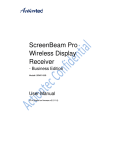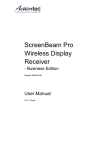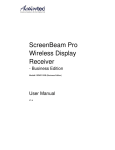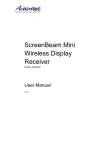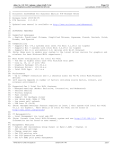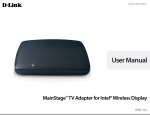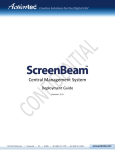Download User Guidev1 ScreenBeam Pro Business Edition
Transcript
Wireless Display Receiver ScreenBeam Pro Business Edition Model # SBWD100B User Guide v1 Table of Contents 1 Introduction 1 Package Contents Features System Requirements 2 Setting Up ScreenBeam Pro Connecting to an HDTV Setting Up the First Time 3 Display andControl Options Managed Meeting Display Mode Ultra-Low Delay 1 2 2 3 3 5 17 17 24 25 4 Device Management 27 Accessing the Web Server Configuring a ScreenBeam Pro Receiver Updating the Receiver’s Firmware A Specifications B Notices 27 30 55 57 59 Warranty GPL Info EU CE Declaration of Conformity Technical Support ii 59 59 60 60 1 Introduction Thank you for purchasing Actiontec’s ScreenBeam Pro Wireless Display Receiver Business Edition. ScreenBeam Pro wirelessly streams what’s on your Intel WiDi or Miracast™ compatible device to your HDTV, including movies, videos, photos, music, and more. ScreenBeam Pro boasts many innovative features, including fast setup, enhanced security and IT manageability, Managed Meeting (Gen 5 WiDi), smooth video playback, full 1080p HD support, ultra-low delay, Windows 8.1 optimization, versatile compatibility, low power consumption, and more. With ScreenBeam Pro, it’s easy to host presentations and impromptu meetings, as users don’t need to scramble to find the right HDMI or VGA cable to share a spreadsheet or presentation. And the Managed Meeting feature allows participants to share their own screens on the projector or HDTV monitor. This user manual will take you through the procedures needed to install, connect, operate, configure, and upgrade ScreenBeam Pro. Package Contents The following items are in the ScreenBeam Pro Business Edition package: s ScreenBeam Pro Business Edition Wireless Display Receiver (1) s HDMI Cable (1) s HDMI-to-VGA adapter (1) s AC power adapter (1) s Quick Start Guide 1 Introduction Features s s Reset Button: resets ScreenBeam Pro to its default setting Video Out Port (HDMI): connects ScreenBeam Pro to HDTV/projector for video and audio output. s Power Input: connects to AC adapter s LED Indicator: displays status of power supply s USB Port: used for firmware upgrades System Requirements sDisplay device with one Type A HDMI port or VGA port sAvailable power outlet Compatible Devices sLaptop or notebook computer with Intel WiDi 4 or higher sSmartphone, sWi-Fi tablet, or laptop running Windows 8.1 Miracast™ certified smartphones and tablets sNon-WiDi/Miracast-ready laptops and PCs with Actiontec USB Transmitter (Windows 7 or higher) 2 Setting Up ScreenBeam Pro 2 This chapter details how to connect ScreenBeam Pro to an HDTV monitor, and how to set it up for the first time. Make sure you have all the contents from ScreenBeam Pro’s package available before beginning the installation. Connecting to an HDTV To connect ScreenBeam Pro to an HDTV monitor, make sure you have the following items handy: s ScreenBeam Pro sHDMI sAC cable power cord To connect ScreenBeam Pro to an HDTV monitor: 1. Plug one end of the supplied HDMI cable into the HDMI port (Video Out) on ScreenBeam Pro, and the other end into an available HDMI port on the HDTV. 2. Plug the other end of the power cord into a nearby electrical outlet. The Power LED will illuminate green. 3 Setting Up ScreenBeam Pro When Steps 1 and 2 are complete, the hardware should be connected as shown in the figure below: 3. Turn on the HDTV and set it to display the input from the HDMI port connected in step 1. 4. Make sure that the Ready To Connect screen appears on the HDTV. The Receiver is now connected to the HDTV monitor, and is ready to use. 4 ScreenBeam Pro - Business Edition Setting Up the First Time This section explains how to connect ScreenBeam Pro for the first time to a source device. There are three source device options: Windows 8.1, Intel WiDi, and Miracast™. Windows 8.1 To connect to a source device running Windows 8.1: 1. From the Windows desktop, go to the Charms menu and select Devices. You can also use the shortcut keys (Windows logo + K). 2. When the Devices menu appears, select Project. 5 Setting Up ScreenBeam Pro 3. When the “Project” menu appears, select Add a wireless display. Windows will search for available devices. Note: If the device is running Windows 8.1 and the previous screens do not appear, go to http://www.actiontec.com/widi81 to update the software. Alternatively, the Windows 8.1 device can be updated via the Windows Update application. 6 ScreenBeam Pro - Business Edition 4. A “PC and devices” screen appears. Click Devices and, from the list that appears, select ScreenBeam Pro. 7 Setting Up ScreenBeam Pro 1. A PIN entry box is displayed on the screen of your Windows 8.1 device and a PIN entry countdown on the HDTV. Type the PIN provided by your network administrator in the PIN entry box and click Next to continue. Note: Obtain the security PIN from your network administrator if no PIN is displayed on the connected display device. By default, the security PIN is “12345670.” If a PIN is displayed on the connected display device (see lower figure), type this PIN in the PIN entry box. 8 ScreenBeam Pro - Business Edition 2. The HDTV displays messages to show the status of the connection. After connection, the device’s screen should be displayed on the HDTV. 9 Setting Up ScreenBeam Pro Intel WiDi To connect to a source device running Intel WiDi: 1. Launch the Intel Wireless Display application on the device. To find the application, go to Windows Search on the device and search for “Intel WiDi”. 2. The application scans for available receivers automatically. Select your ScreenBeam Pro and click Connect. (The “Connect Automatically” checkbox is optional.) If your ScreenBeam Pro is not listed, click Scan. 10 ScreenBeam Pro - Business Edition 3. A PIN entry box is displayed on the WiDi device’s screen, and a PIN entry countdown on the HDTV. Type the PIN provided by your network administrator in the PIN entry box on the WiDi device, then click Continue. Note: Obtain the security PIN from your network administrator if no PIN is displayed on the connected display device. By default, the security PIN is “12345670.” If a PIN is displayed on the connected display device (see lower figure), type this PIN in the PIN entry box. 11 Setting Up ScreenBeam Pro 4. The HDTV displays messages to show the status of the connection. 5. A “Connection Successful” screen appears on the device’s screen. Click Finished, and the device’s screen is displayed on the HDTV. 12 ScreenBeam Pro - Business Edition Adjusting the HDTV Picture If edges of the device screen cannot be seen on the HDTV screen, or there are black around the picture, ScreenBeam Pro’s cropping settings can be adjusted. To do this: 1. From the Intel WiDi application, click Settings. 2. The Settings screen appears. Click Picture and Sound. 3. The Picture and Sound screen appears. Select Adjust cropping. 13 Setting Up ScreenBeam Pro 4. Adjust the HDTV picture by clicking + (plus sign) or - (minus sign). WiDi Software Version Support Make sure the device supports Intel Wireless Display (WiDi) software version 3.5 or higher. To find out which version of Intel WiDi the device is running, launch the Intel WiDi application and click Help, then navigate to the About Intel® WiDi screen. To obtain the latest Intel WiDi software and drivers, go to: http://www.intel.com/go/wirelessdisplayupdate or click Check Intel® WiDi website for updates. 14 ScreenBeam Pro - Business Edition Miracast™ To connect a Miracast™-enabled Android device to the ScreenBeam Pro, use the following procedure. For best performance, the Miracast™ device should be running the latest software. 1. On a Miracast™-enabled Android device, locate and open the Wireless Display Application (check for the application under Settings). Note: The name of the Wireless Display application depends on the device type and model. Refer to the device’s user manual for more details. 2. The Wireless Display application scans for available devices. Select ScreenBeam Pro from the device list. You may be required to enter a PIN. Note: Obtain the security PIN from your network administrator if no PIN is displayed on the connected display device. By default, the security PIN is “12345670.” If a PIN is displayed on the connected display device, enter this PIN in the PIN text box. 3. Enter the PIN in the PIN text box, then click Connect. 4. Wait for the device to pair with and connect to your receiver. When it does, the device’s screen will be displayed on the HDTV. 15 Setting Up ScreenBeam Pro Tips for Optimal Performance To get the most out of ScreenBeam Pro, note the following: s s s Keep ScreenBeam Pro in line-of-sight in relation to the source device. Doing this will help ensure ScreenBeam Pro receives the best possible signal. ScreenBeam Pro’s optimal wireless range is within 30 feet of the source device. However, actual range and effectiveness depends on many factors, including the amount of existing signal interference and the building materials used in the surrounding structure. Avoid placing ScreenBeam Pro near other possible sources of interference (such as electric fans or other devices with electric motors), microwave ovens, and cordless phones. 16 Display and Control Options 3 This chapter describes the various display modes and control optionsupported by ScreenBeam Pro - Business Edition. Managed Meeting ScreenBeam Pro supports Managed Meeting, which is provided with Intel WiDi (Gen 5). Managed Meeting allows meeting participants to share their screens interactively, or allows the owner (the first connected user who has set the interactive mode to “I can request others to present”) to manage other participants. There are three meeting modes available when the Managed Meeting function is enabled: s Only 1 present - No one else can share or take control. s Others can request to present - Other people can request control/sharing. s I can request others to present - you control sharing To use these meeting modes, you must enable Managed Meeting in the local management server. Refer to the section titled “Setting up Managed Meeting,” in this chapter. Note: The Gen 5 Intel WiDi (WiDi 5.x.x.x) requires the Haswell systems. 17 Display Options Only 1 Present This is an exclusive meeting mode, which gives you dedicated control/use of the ScreenBeam Pro wireless display. In this mode, other people cannot request control/sharing to the wireless display. To activate “Only 1 Present” mode, click in the appropriate button in the Intel Pro WiDi screen. When this mode is active, other devices cannot connect to the projector/monitor. The follwing information screen appears when this mode is activated. 18 ScreenBeam Pro - Business Edition Others Can Request to Present To share the projector/display with other attendees, select “Others can request to present” mode. This allows others with Intel Pro WiDi devices to request to share the projector/display. The sharing mode remains in effect until the device is disconnected from the projector/display. To connect to ScreenBeam Pro when in sharing mode, a request is made. 19 Display Options The request is sent. A message appears on the presenter’s device. Click Accept to switch control to the device making the request, and the participant’s device’s screen will immediately be shown on the projector/display. Clicking Decline rejects the request. Any participant can click Disconnect (or close Intel Pro WiDi) to quit the meeting. The presenter can click End Meeting (or close Intel Pro WiDi) to end the meeting. 20 ScreenBeam Pro - Business Edition I Can Request Others to Present To request other attentdees to share the projector/display, select “I can request others to present” mode. This allows the presenter to request that other attendees with Intel Pro WiDi devices share the projector/display. The sharing mode remains in effect until the device is disconnected from the projector/display. Selecting this mode generates a new screen, with possible participants listed. 21 Display Options Clicking on a participant sends an invitation to the particpant. Click Cancel to rescind the invitation. A invitation appears on the chosen participant’s device. Click Accept to present, or Decline to reject. 22 ScreenBeam Pro - Business Edition If the invited participant accepts the invitation, his/her device’s screen will immediately be shown on the projector/display. Sharing information is also displayed on the manager’s WiDi screen: To resume presenting from the manager’s device, click Start presenting. 23 Display Options Display Mode ScreenBeam Pro supports three display modes when connected with a compatible wireless display application (Intel WiDi or Windows 8.1 Project, for example). In Windows, press the Windows logo + P keys simultaneously to launch the display options and select the desired display mode from the options. Duplicate The Duplicate mode is used to display the same content on both the device’s screen and the HDTV simultaneously. Note: There may be minor delay between the content displayed on the HDTV screen compared to the device’s screen. This is due to the current state of wireless display technology. 24 ScreenBeam Pro - Business Edition Extend The Extend mode creates a single, extended “screen” between the source device and the HDTV. When in Extend mode, dragging windows to the right side of the device’s screen displays those windows on the HDTV, while dragging windows to the left of the HDTV screen displays them back on the device’s screen. This mode allows users to display selected content on the HDTV, while all other windows remain on the device’s screen. When this mode is first selected, the HDTV displays only the Windows desktop. Second Screen Only The Second Screen Only mode causes the HDTV to be the only display for the device. All content will be displayed on the HDTV; the source device’s screen will be blank. Ultra-Low Delay ScreenBeam Pro also supports Ultra-Low Delay mode, which helps reduce end-toend wireless display latency. Real-time applications, such as games, can run without noticeable delay when Ultra-Low Delay mode is enabled on supported devices. Intel WiDi You can activate Ultra-Low Delay on a device running Intel WiDi 3.5 or higher. Follow the steps below to switch to ultra-low delay mode: 1. Launch the Intel WiDi application, connect to ScreenBeam Pro, then click Settings. 25 Display Options 2. In the “Settings” screen, select Current Display Settings. NVIDIA Shield To activate ultra-low delay with NVIDIA Shield running: 1. Go to “Settings”, then select Miracast. 2. Tap on the toggle switch to turn “Game Mode” on. Note: The output resolution will be set to 720P once this mode is enabled. Refer to the device’s user manual for more information. 26 Device Management 4 This chapter describes managing the ScreenBeam Pro Receiver using the provided local management web server. Using the web server, the Receiver can be setup, configured, and upgraded. Accessing the Web Server There are two ways to log into the local management web server: with Autonomous GO enabled, and with Autonomous GO disabled. Autonomous GO Enabled When Autonomous GO is enabled, the SSID of the Receiver is not available. To connect to the Receiver: 1. Connect a device (such as a computer) to the Receiver via USB cable. 2. On the device, enter http://192.168.16.1 into a web browser’s address bar. 3. The web server login screen appears. Enter the user name and password into the appropriate text boxes to log in. Note: By default, the user name is “Administrator” and password is “WiDi.” Both the user name and password are case sensitive. These can be modified in the local management web page. See “Resetting User Name and Password” on page 31 for more details. 27 Device Management Autonomous GO Disabled 1. Connect to the Receiver’s SSID from a wireless-enabled laptop (or another device with Wi-Fi and a web browser). You can find the SSID in the lower part of the Ready to connect screen. If the network information display is disabled, the SSID is “Actiontec-SBWDxxxxxx,” with the last four characters being the last four of the Receiver’s name. 2. Click the wireless network icon to open the Networks window, and select the Receiver’s SSID. 28 ScreenBeam Pro - Business Edition 3. The Connect to a Network window appears. Enter the network security key in the Security key text box, then click OK. The default network security key is “1234568.” 4. Open a web browser and enter http://192.168.16.1 in the address bar. 5. The web server login screen appears. Enter the user name and password into the appropriate text boxes to log in. Note: By default, the user name is “Administrator” and password is “WiDi.” Both the user name and password are case sensitive. These can be modified in the local management web page. See “Resetting User Name and Password” on page 31 for more details. 29 Device Management Logging Out To log out from the web server, click on the Logout tab. In the Logout window, click Yes. Configuring a ScreenBeam Pro Receiver Once logged into the web server, Receivers can be configured via the network. Renaming a Receiver To rename a Receiver: 1. Click Device Configuration. 2. The Device Configuration window appears. Click in the Enable check box next to Device Name Access. 30 ScreenBeam Pro - Business Edition 3. Enter a new name in the Device Name text box.. 4. Click Apply. 5. In the Message from webpage window that appears, click OK. The Receiver is renamed. Resetting User Name and Password To change the user name and password for logging into the web server: 1. Click Device Configuration. 31 Device Management 2. The Device Configuration window appears. Enter the new user name and password in the appropriate text boxes. 3. In the Message from webpage window that appears, click OK. The user name and password are changed. Changing Display Language The language of the Receiver’s display can be changed. Note that this procedure does not change the language of the web server configuration windows. To change the language on the Receiver’s display: 1. Click Device Configuration. 32 ScreenBeam Pro - Business Edition 2. The Device Configuration window appears. Select a language from the Display Language drop-down menu. Currently available languages are Dutch, English, French, Japanese, Korean, Simplified Chinese, Traditional Chinese, Spanish, and German. 3. Click Apply. 4. In the Message from webpage window that appears, click OK. The language of the Receiver’s display is changed. 33 Device Management Setting Up Network Information Display To show network information on the Receiver’s display: 1. Click Network Settings. 2. The Network Settings window appears. Scroll down to the Show network information on TV screen options. Click in the Enable radio button. 3. Click Apply. 4. In the Message from webpage window that appears, click OK. 34 ScreenBeam Pro - Business Edition The network information is shown on the Receiver’s connected display. Setting Up Autonomous Group Owner (AGO) The Autonomous Group Owner option allows a Receiver to be designated as group owner during a P2P connection negotiation. Additionally, the Receiver can determine the channel for communication. In a Wi-Fi P2P group, the group owner operates as an access point and all other devices are clients. After AGO is enabled, the designated Receiver works as the P2P group owner. To set up AGO: 1. Click Network Settings. 35 Device Management 2. The Network Settings window appears. Scroll down to the Autonomous Group Owner (AGO) options. Select an option by clicking in its radio button. Enable: selecting this option allows the Receiver to define the communication channel. Access control of Managed Meeting and channel selection is available. Disable: selecting this option causes the communication channel to remain the same as the source device, or determined through negotiation between the Receiver and connecting device. Access control of Managed Meeting and channel selection is not available. 3. Click Apply. 4. In the Message from webpage window that appears, click OK. The Receiver reboots. When complete, the new settings are enabled. 36 ScreenBeam Pro - Business Edition Setting Up Group Owner Intent When the AGO option is disabled, Group Owner Intent is available. This option determines which device (Receiver or connecting device) will be the group owner. To set up Group Owner Intent: 1. Click Features. 2. Enter a value in the Group Owner Intent text box. The larger the value, the more likely the Receiver becomes the group owner of the P2P connection. 3. Click Apply. 4. In the Message from webpage window that appears, click OK. The Receiver reboots. When complete, the new settings are enabled. 37 Device Management Setting Up Managed Meeting When the AGO option is enabled, Managed Meeting is available. This option allows meeting participants to share the wireless display. To set up Managed Meeting: 1. Click Features. 2. Scroll down to the Managed Meetings section. Enable/disable Managed Meeting by clicking in the appropriate radio button. 3. For better communication, you can define a port for the Managed Meeting. To do this, enter a port number in the Managed Meeting Port text box. 4. Click Apply. 38 ScreenBeam Pro - Business Edition 5. In the Message from webpage window that appears, click OK. The Receiver reboots. When complete, the new settings are enabled. Setting Up Communication Channel When AGO is enabled, a communication channel between the Receiver and source device can be opened. To set up Communication Channel: 1. Click Network Settings. 39 Device Management 2. The Network Settings window appears. Scroll down to the Channel Number section. Select the desired channel from the Channel Number drop-down menu. Select a lightly-used channel in the network environment. Generally, less-busy channels provide better performance. Channels from 1 to 11 are in the 2.4 GHz band; channels from 36 to 165 are in the 5 GHz band. 3. Click Apply. 4. In the Message from webpage window that appears, click OK. The Receiver reboots. When complete, the new settings are enabled. 40 ScreenBeam Pro - Business Edition Setting Up P2P Network Parameters When AGO is enabled, network parameters for peer-to-peer (P2P) connections, including P2P wireless network name (SSID), password, IP address, subnet mask, and DHCP IP address range can be defined To set up P2P network parameters: 1. Click Network Settings. 2. The Network Settings window appears. Scroll down to the Wireless Interface Setting section. 3. Enter a P2P address in the appropriate text boxes. This is IP address of the Receiver in a P2P connection. The address appears in the left corner of the Ready to connect screen. 4. Enter a P2P subnet mask address in the appropriate text boxes. This is the subnet mask for the network established in the P2P connection. 5. Enter the P2P DHCP start and end addresses in the appropriate text boxes. These define the range of IP addresses assigned to the connected devices. Note: P2P Wireless Network Name (SSID) and P2P Wireless Network Password are not configurable at this time. 41 Device Management 6. Click Apply. 7. In the Message from webpage window that appears, click OK. The Receiver reboots. When complete, the new settings are enabled. Setting Up Ethernet IP Parameters The Ethernet Interface Setting is used to configure the Ethernet IP address for the connected USB-to-Ethernet adapter. To do this: 1. Click Network Settings. 42 ScreenBeam Pro - Business Edition 2. The Network Settings window appears. Scroll down to the Ethernet Interface Setting section. 3. Enter a IP address in the appropriate text boxes. 4. Enter a subnet mask address in the appropriate text boxes. 5. Click Apply. 6. In the Message from webpage window that appears, click OK. The Receiver reboots. When complete, the new settings are enabled. Now, when a USB-to-Ethernet adapter is connected to the Receiver, this IP address is displayed in the lower part of the Ready to connect screen. Users can use this IP address to access the local management server. 43 Device Management Setting Up WiDi Lower Bandwidth The WiDi Lower Bandwidth setting is used to control video quality and speed. To configure: 1. Click Features. 2. The Features window appears. Enable/disable WiDi Lower Bandwidth. Enabling this setting limits the bandwidth for WiDi, smoothing video playback. Disabling results in better video quality on uncongested networks. 3. Click Apply. 4. In the Message from webpage window that appears, click OK. WiDi Lower Bandwidth is configured. Setting Up HDCP Encryption The HDCP Encryption setting is used to improve connection speed and compatibility. To set up: 1. Click Features. 44 ScreenBeam Pro - Business Edition 2. The Features window appears. Enable/disable HDCP Encryption. Enabling this setting allows HDCP-protected media to be played. Disabling improves connection speed and compatibility, but HDCP-protected media cannot be played. 3. Click Apply. 4. In the Message from webpage window that appears, click OK. The Receiver reboots. When complete, the new settings are enabled. Setting Up PIN Pairing Method The PIN Pairing Method setting allows the user to define a PIN pairing method when connecting to the Receiver. To set up: 1. Click Features. 45 Device Management 2. The Features window appears. Scroll down to the Force PIN Pairing on First Connection section, then click in the appropriate radio button. Turning this setting on forces the user to enter a PIN code to access the Receiver for the first time. Turning this setting off disables PIN pairing; PIN entry or PBC must be used when connecting to the Receiver for the first time. 3. If PIN pairing is turned on in step 3, the PIN Generation Method is accessible. If Random is selected, a PIN code is generated randomly by the system and displayed on the connected display. If Static is selected, a seven-digit PIN code can be entered in the appropriate text box. After entering the seven digits, the system generates an eight-digit code and displays it in the Static PIN text box. This PIN will not be displayed on the connected display. 4. Click Apply. 5. In the Message from webpage window that appears, click OK. The PIN Pairing setting is configured. 46 ScreenBeam Pro - Business Edition Setting Up USB Local Access The Receiver features a USB port for various uses. To set up the USB port: 1. Click Features. 2. The Features window appears. Scroll down to the USB Local Access section, then select one of the options. Disable: selecting this option disables the USB port. Only allow firmware update: selecting this option allows the USB port to be used for firmware updates only. Enable: allows full functionality for the USB port, including firmware updates or control of the source device via a keyboard/mouse connected to the Receiver. If this option is chosen, select a method (UIBC or UoIP). Note: If UIBC is selected, the keyboard will not support combo keys. and the mouse will not support right clicks. UoIP is supported by Intel WiDi only. 3. Click Apply. 47 Device Management 4. In the Message from webpage window that appears, click OK. The USB Local Access setting is configured. Managing HDMI Port Output The Receiver has options to control HDMI output. To configure: 1. Click Features. 2. The Features window appears. Scroll down to the HDMI Port Power management section, then select one of the options. Always on: selecting this option keeps the HDMI output on. Screensaver: selecting this option allows the system to run a screensaver after the defined idle time expires. Use the Wait menu to define an idle time. HDMI off: selecting this option turns the HDMI output off after the defined idle time expires. Use the Wait menu to define an idle time. 48 ScreenBeam Pro - Business Edition 3. Click Apply. 4. In the Message from webpage window that appears, click OK. The HDMI Port Output setting is configured. Adjusting TV Screen Size The Receiver has options to adjust the screen size appearing on the connected display. This option is useful to adjust the image on the display if it is too big or too small. To configure: 1. Click Features. 2. The Features window appears. Scroll down to the TV Screen Size (Overscan Settings) section, then select one of the options. 49 Device Management 3. Click Apply. 4. In the Message from webpage window that appears, click OK. The TV Screen Size setting is configured. Updating Background Image To update the Receiver’s background image: 1. Click Features. 2. The Features window appears. Scroll down to the Background Image section, then click Browse. 50 ScreenBeam Pro - Business Edition 3. The Choose File to Upload window appears. Select an image for the background, then click Open. The image must be either a .png or a .jpeg/.jpg file and not exceed 2.5 MB in size, with optimum dimensions of 1280 x 720 pixels. 4. Click Apply. 5. In the Message from webpage window that appears, click OK. The Background Image setting is configured. 51 Device Management Updating the Screensaver Image To update the Receiver’s screensaver image: 1. Click Features. 2. The Features window appears. Scroll down to the Screen Saver Image section, then click Browse. 3. The Choose File to Upload window appears. Select an image for the screensaver, then click Open. The image must be a .png file and not exceed 200 KB in size, with optimum dimensions of 300 x 60 pixels. 4. Click Apply. 52 ScreenBeam Pro - Business Edition 5. In the Message from webpage window that appears, click OK. The Screensaver Image setting is configured. Rebooting the Receiver To reboot the Receiver: 1. Click Maintenance. 2. The Maintenance window appears. Scroll down to the Reboot Receiver section, then click Yes. 53 Device Management 3. In the Message from webpage window that appears, click OK. The Receiver reboots. Resetting the Receiver to Factory Defaults To reset the Receiver to its factory default settings: 1. Click Maintenance. 2. The Maintenance window appears. Scroll down to the Reset Settings to Factory section, then click Yes. 3. In the Message from webpage window that appears, click OK. 54 ScreenBeam Pro - Business Edition The Receiver reboots. When complete, the Receiver will be operating with its factory default settings. All custom settings are erased. Resetting Factory Defaults Manually The Receiver can also be reset to factory default settings manually. To do this: 1. Power on the Receiver, and wait until the Ready to Connect screen appears on the connected monitor. 2. Hold down the Receiver’s Reset button with a pin or straightened paper clip. 3. When the Reset to Default screen appears on the monitor, release the Reset button. The Receiver reboots, and it will be operating with its default settings. Updating the Receiver’s Firmware Actiontec periodically provides firmware updates to add functionality and/or eradicate bugs. To update the Receiver’s firmware: 1. Click Firmware Upgrade. 2. The Firmware Upgrade window appears. Select Enable from the Firmware Update menu. 55 Device Management 3. Disconnect the computer from the Receiver’s SSID and connect to a router’s SSID. The Receiver should also be physically disconnected from the computer. 4. Download the latest firmware from Actiontec’s website: http://www.actiontec.com/sbupdate 5. Extract the zip file. There will be an autorun folder and an install.img file in the extracted file folder. 6. Insert a USB flash drive into the computer. Note: Do not use a portable hard drive. Use a FAT/FAT32 formatted USB flash drive only. 7. Copy the autorun folder and the install.img file to the root directory of the USB flash drive. 8. Power on the Receiver. Make sure the Ready To Connect screen appears on the connected monitor. 9. Remove the USB flash drive from the computer and plug it into the USB port of the Receiver. 10.The Receiver starts to update its firmware. Firmware upgrade status messages will appear on the connected monitor. Warning! Do not power off the Receiver or remove the USB flash drive while the update is in progress. 11.The Receiver reboots. The firmware upgrade is complete when the Ready To Connect screen reappears. The Receiver’s firmware is updated. 56 A Specifications Video H.264 compression Supports up to full HD 1080p30 resolution Audio LPCM & AAC Supports up to 5.1 channels A/V interface HDMI Type-A female connector VGA with HDMI-to-VGA adapter model no. YZ-050 (included); supports the following: s VGA output, 10-bit resolution up to 165MHz, pixel rate of up to 1080p, and UXGA s LPCM and compressed surround sound s Extron RJ45-to-VGA wired projector (up to 100’) s VGA output: 480I/P, 576I/P, 720P, 1080I/P, 640x480, 800x600, 1024x768, 1280x720, 1280x768, 1280x800, 1280x960, 1360x768, 1366x768, and 1920x1080 Note: Does not support protected content playback Wireless 802.11 a/b/g/n Dual-band 2.4 & 5 GHz WPA2, WPS virtual PBC, AES 128-bit Content Protection HDCP 2.x for HDMI Electrical Input: 5V/2A Consumption: Less than 4W 57 Specifications Firmware Upgrade Wireless upgrade USB Certifications Wi-Fi Miracast™ (pending) Intel® WiDi (Gen 4) (pending) Regulatory Compliance FCC, IC, and UL Warranty 1 year, limited Environmental Operating temperature: 0 ºC to 40 ºC (32 ºF to 104 ºF) Storage temperature: 0 ºC to 70 ºC (32 ºF to 158 ºF) Operating humidity: 10% to 85%, non-condensing Storage humidity: 5% to 90%, non-condensing Compatibility Intel WiDi-ready Ultrabooks, laptops, and tablets Wi-Fi Miracast smartphones, tablets, and laptops running Windows 8.1 or Android 4.2 and higher Non-WiDi/Miracast ready laptops and PCs with Actiontec USB Transmitter running Windows 7 and higher Not compatible with Apple devices System Requirements Windows 8.1 or higher (with Miracast support) Intel WiDi capable laptop or tablet with Intel WiDi 4 (and higher) Wi-Fi Miracast capable smartphone, or tablet, or laptop Note: Specifications are subject to change without notice. 58 B Notices Warranty This product has a one-year Limited Hardware Warranty and 90-day free software updates from the date of purchase. Local Law This Limited Warranty Statement gives the customer specific legal rights. The customer may also have other rights which vary from state to state in the United States, from province to province in Canada, and from country to country elsewhere in the world. To the extent that this Limited Warranty Statement is inconsistent with local law, this Statement shall be deemed modified to be consistent with such local law. Under such local law, certain disclaimers and limitations of this Warranty Statement may not apply to the customer. Go to http://www.actiontec.com/products/warranty.php for more information. GPL Info For GNU General Public License (GPL) related information, go to http://opensource.actiontec.com. 59 Specifications EU CE Declaration of Conformity To obtain the complete Declaration of Conformity form in softcopy, go to the Actiontec Electronics Declarations of Conformity EU/EEA website at http://international.actiontec.com/support/doc. The symbol below is placed in accordance with the European Union Directive 2002/96 on the Waste Electrical and Electronic Equipment (the WEEE Directive). If disposed of within the European Union, this product should be treated and recycled in accordance with the laws of your jurisdiction implementing the WEEE Directive. Technical Support Go to http://www.actiontec.com/sbupdate for product support, updates, and more information including: s Firmware updates s Troubleshooting s Registration s FAQs Technical Support Phone Number United States: 1-888-436-0657 60






























































